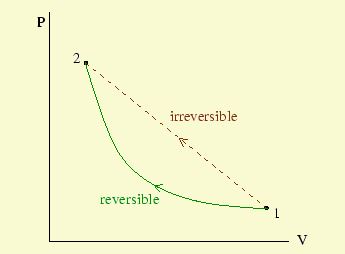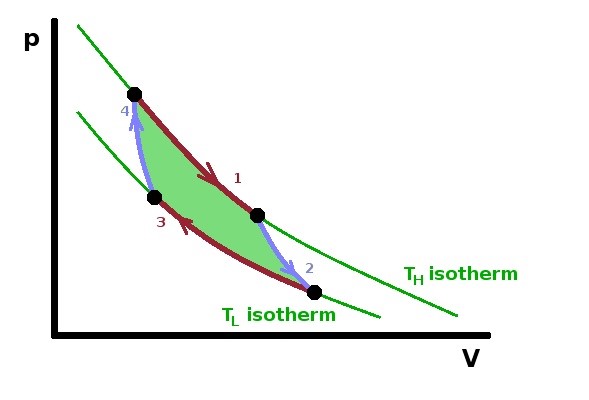An adiabatic process may or may not be reversible. For an adiabatic process to be reversible it must satisfy few other conditions.
An adiabatic process can be reversible, however all adiabatic processes are not reversible by default. Before we come to reversible adiabatic process, we must first understand the factors that decide reversibility or irreversibility of a system in thermodynamics.
A reversible process in thermodynamics can be defined as the one, which can be retracted back to its initial stage and in doing the same no residual change or hysteresis is left either in the system or the surroundings. A reversible process occurs in a state of quasi-equilibrium; i.e. the system is always at equilibrium with its surroundings.
A reversible process has an efficiency of 100%. This implies, the energy required to carry out the state change is minimum and there is no loss of energy to the surrounding as heat. In other words, in a reversible process the work done is maximum for the amount of energy provided as an input. This type of process is an ideal process where there is no friction.

As shown in the picture above, while moving from point 1 to point 2, the reversible shall always be at equilibrium with its surroundings, while for an irreversible process the same is not so. Because of this characteristic, a reversible process is carried out infinitesimally slowly.
A cyclic reversible process is depicted by the theoretical carnot cycle. The theoretical carnot cycle is defined by two steps each of isothermal and adiabatic processes. The red lines in the figure below

indicate the isothermal steps and the blue lines denotes the adiabatic steps.
Another aspect of a thermodynamic process is Entropy, which defines the reversibility or irreversibility of a process. The delta change in entropy or randomness of a system and surroundings remains constant in an isothermal process; whereas the irreversibility of a process is characterised by increase in the total entropy.
How Adiabatic Process Can Be Reversible?
An adiabatic process is defined by dQ=0, where Q is the amount of heat transferred between the system and surroundings.
An adiabatic process is an ideal process which is perfectly insulated from the surroundings and no heat transfer between the system and the surroundings can take place. Adiabacity of a process doesn’t qualify it to be called reversible as well.
An adiabatic process is reversible if it is isoentropic as well. In other words, there is no change in entropy.If a process is adiabatic i.e if the system has adiabatic walls and PdV work is done on the system, there is no exchange of heat with the surrounding and entropy change in this case is zero.
What is the Difference Between Reversible And Irreversible Adiabatic Process?
The reversible and irreversible adiabatic process is differentiated by change in entropy of the process.
A reversible process is an idealized process involving ideal gas in ideal conditions.When a process change takes place reversibly, the process can be retracted back to its initial stage and while doing the same, no hysteresis is left either in the system or the surroundings.
A reversible process occurs infinitesimally slowly and each step is in equilibrium with other. This is also called quasi-static. There is no change in entropy of the process in a reversible process. An idealized reversible adiabatic process does not exist in nature and cannot be achieved experimentally.
An example of a reversible adiabatic process is adiabatic expansion of a real gas.
Irreversible process on the other hand is the changes occurring in real life. An adiabatic irreversible process involves change that takes place with increase in entropy of the system. An example of an irreversible adiabatic process is free expansion of an ideal gas in a cylinder which is perfectly insulated as shown in the figure below.

This is also an idealised thought experiment, wherein an ideal gas is kept in a cylinder with adiabatic walls having a partition, the other side of which is kept in vacuum. The gas is allowed to expand by making a hole in the partition. Since the gas is expanding into vacuum, there is no external pressure to act against and hence the work done is zero.
Thus from the first law of thermodynamics, since both dQ and dW are zero, the internal energy change dU is also zero. In case of an ideal gas, internal energy depends only on temperature and since the net change in internal energy is zero, the temperature also remains constant. Now at constant temperature, the entropy is proportional to volume and since volume increase, so does the entropy.
How do you know if a process is Reversible or Irreversible?
Reversible processes are idealized and theoretically thought off processes in order create a comparison with actual processes, all of which are irreversible. All the processes that occur naturally have some amount of irreversibility in them.
For a process to be reversible the change must be at equilibrium with the preceding step or the change must be infinitesimally small. Such processes are called quasi-static and they require infinite time to be carried out. The work done in a reversible process is maximum possible.
Another aspect of a reversibility of irreversibility of a process is the measure of its entropy. Idealised reversible processes are isoentropic or the dS = 0 for the system and the surroundings.
Since, reversible processes are idealized cases with maximum efficiency; the amount of irreversibility is reflected in the reduced efficiency of a process from its ideal behaviour. Lower the irreversibility, higher its efficiency.
Some examples of reversible processes are frictionless movement,current flow with zero resistance (superconductivity), mixing of two samples of the same substance at same state.
Some perfectly irreversible processes are what we see in our day to day like birth or death or a bomb explosion. Others include movement of a vehicle on road, lighting a bulb, cooking food etc.
Work Done in Reversible Adiabatic Process
Since reversible adiabatic process is a ideal process, the work done is calculated based on ideal gas consideration.
The work done expression is thus derived by considering expansion or compression of 1 mole of an ideal gas from Condition (P1, V1) to condition (P2, V2).
The work done for an adiabatic process, is shown by following PV diagram

For adiabatic consideration, dQ= 0 and for Reversible consideration dW= -pdV
For an ideal gas,
Internal energy, dU= CvdT

Therefore from 1st law of thermodynamics,
dU = -pdV
CvdT= -pdV
For an ideal gas 1 mole,

Please click to learn more on real gas examples.

I am Sangeeta Das. I have completed my Masters in Mechanical Engineering with specialization in I.C Engine and Automobiles. I have around ten years of experience encompassing industry and academia. My area of interest includes I.C. Engines, Aerodynamics and Fluid Mechanics. You can reach me at